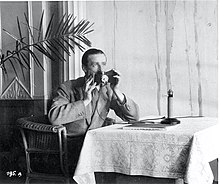
The Metropolitan Transportation Authority (MTA) is a public benefit corporation responsible for public transportation in the New York City metropolitan area of the U.S. state of New York. The MTA is the largest public transit authority in North America, serving 12 counties in Downstate New York, along with two counties in southwestern Connecticut under contract to the Connecticut Department of Transportation, carrying over 11 million passengers on an average weekday systemwide, and over 850,000 vehicles on its seven toll bridges and two tunnels per weekday.
A bleep censor is the replacement of offensive language or classified information with a beep sound, used in television and radio.

Classified advertising is a form of advertising, particularly common in newspapers, online and other periodicals, which may be sold or distributed free of charge. Classified advertisements are much cheaper than larger display advertisements used by businesses, although display advertising is more widespread. They were also commonly called "want" ads, starting in 1763, and are sometimes called small ads in Britain.

Direct marketing is a form of communicating an offer, where organizations communicate directly to a pre-selected customer and supply a method for a direct response. Among practitioners, it is also known as direct response marketing. In contrast to direct marketing, advertising is more of a mass-message nature.

The Carterfone is a device invented by Thomas Carter. It connects a two-way radio system to the telephone system, allowing someone on the radio to talk to someone on the phone. This makes it a direct predecessor to today's autopatch. The connection is acoustic -- sound travels through the air between the Carterfone and a conventional telephone that is part of the telephone system.
Online advertising, also known as online marketing, Internet advertising, digital advertising or web advertising, is a form of marketing and advertising that uses the Internet to promote products and services to audiences and platform users. Online advertising includes email marketing, search engine marketing (SEM), social media marketing, many types of display advertising, and mobile advertising. Advertisements are increasingly being delivered via automated software systems operating across multiple websites, media services and platforms, known as programmatic advertising.
Pay to surf (PTS) is an online business model which gained popularity in the late 1990’s and experienced a significant decline following the dot-com crash. PTS companies advertised their main advantage as sharing the advertising revenue with their user base in a form of rewards for watching promotional content over the web. In order to participate, users would need to install software that tracked their browsing activities and displayed targeted advertisements. Ultimately, users receive financial compensation for their time spent browsing the web.

Hush-A-Phone v. United States, 238 F.2d 266 was a seminal ruling in United States telecommunications decided by the D.C. Circuit Court of Appeals. Hush-A-Phone Corporation marketed a small, cup-like device which mounted on the speaking party's microphone, reducing the risk of conversations being overheard and increasing sound fidelity for the listening party. At the time, AT&T had a near-monopoly on America's phone system, even controlling the equipment attached to its network. In this era, Americans had to lease equipment from "Ma Bell" or use approved devices. At this time Hush-A-Phone had been around for 20 years without any issues. However, when an AT&T lawyer saw one in a store window, the company decided to sue on the grounds that anything attached to a phone could damage their network.

Leo Leroy Beranek was an American acoustics expert, former MIT professor, and a founder and former president of Bolt, Beranek and Newman. He authored Acoustics, considered a classic textbook in this field, and its updated and extended version published in 2012 under the title Acoustics: Sound Fields and Transducers. He was also an expert in the design and evaluation of concert halls and opera houses, and authored the classic textbook Music, Acoustics, and Architecture, revised and extended in 2004 under the title Concert Halls and Opera Houses: Music, Acoustics, and Architecture.
In the United States, commercial radio stations make most of their revenue by selling airtime to be used for running radio advertisements. These advertisements are the result of a business or a service providing a valuable consideration, usually money, in exchange for the station airing their commercial or mentioning them on air. The most common advertisements are "spot commercials", which normally last for no more than one minute, and longer programs, commonly running up to one hour, known as "informercials".

Embarq Corporation was the largest independent local exchange carrier in the United States, serving customers in 18 states and providing local, long-distance, high-speed data and wireless services to residential and business customers. It had been formerly the local telephone division (LTD) of Sprint Nextel until 2006, when it was spun off as an independent company. Embarq produced more than $6 billion in revenues annually, and had approximately 18,000 employees. It was based in Overland Park, Kansas.
Apple Inc. has had many notable advertisements since the 1980s. The "1984" Super Bowl commercial introduced the original Macintosh mimicking imagery from George Orwell's 1984. The 1990s Think Different campaign linked Apple to famous social figures such as John Lennon and Mahatma Gandhi, while also introducing "Think Different" as a new slogan for the company. Other popular advertising campaigns include the 2000s "iPod People", the 2002 Switch campaign, and most recently the Get a Mac campaign which ran from 2006 to 2009.
Mobile advertising is a form of advertising via mobile (wireless) phones or other mobile devices. It is a subset of mobile marketing, mobile advertising can take place as text ads via SMS, or banner advertisements that appear embedded in a mobile web site.
Location-based advertising (LBA) is a form of advertising that integrates mobile advertising with location-based services. The technology is used to pinpoint consumers location and provide location-specific advertisements on their mobile devices.

Targeted advertising is a form of advertising, including online advertising, that is directed towards an audience with certain traits, based on the product or person the advertiser is promoting.
Social network advertising, also known as social media targeting, is a group of terms used to describe forms of online advertising and digital marketing focusing on social networking services. A significant aspect of this type of advertising is that advertisers can take advantage of users' demographic information, psychographics, and other data points to target their ads.

Verizon Communications Inc., commonly known as Verizon, is an American multinational telecommunications conglomerate. The company is incorporated in Delaware, and headquartered at 1095 Avenue of the Americas in Midtown Manhattan, New York City. Verizon's capital stock is a component of the Dow Jones Industrial Average. It is the world's second-largest telecommunications company by revenue.

195 Broadway, also known as the Telephone Building, Telegraph Building, or Western Union Building, is an early skyscraper on Broadway in the Financial District of Manhattan in New York City. The building was the longtime headquarters of AT&T Corp. and Western Union. It occupies the entire western side of Broadway from Dey to Fulton Streets.

United States v. AT&T, 552 F.Supp. 131 (1982), was a ruling of the United States District Court for the District of Columbia, that led to the 1984 Bell System divestiture, and the breakup of the old AT&T natural monopoly into seven regional Bell operating companies and a much smaller new version of AT&T.

The Traffic Motor Truck Corporation (TMTC) was a St. Louis truck manufacturer from 1917 to 1929. It used Continental engines chiefly, and sometimes Gray Victory engines. The company was based at 5200 North Second Street. Guy C. Wilson was TMTC's president and Theodore C. Brandle was its vice president. Stephen W. Avery was the company's advertising manager.













